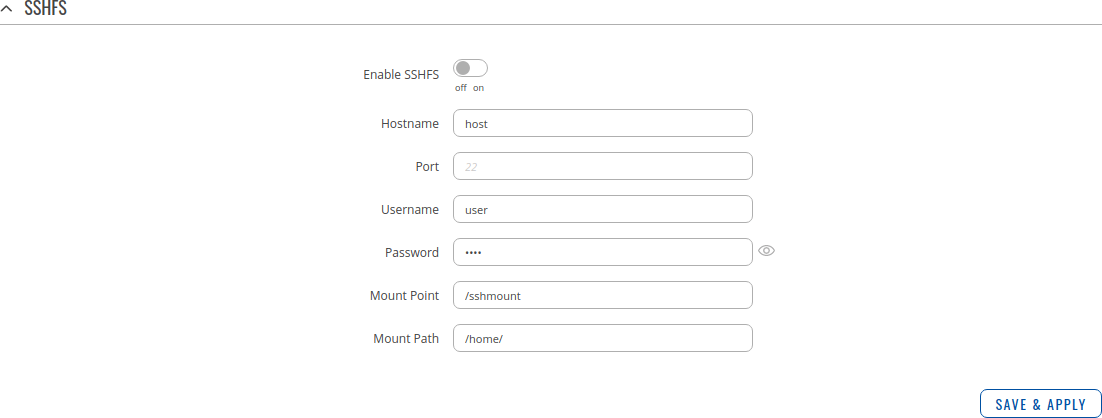Template:Networking rutos manual sshfs: Difference between revisions
No edit summary |
No edit summary |
||
| Line 21: | Line 21: | ||
<b>SSHFS</b> configuration consists of setting up authentication, port and mount information parameters. Below is an example oh the SSHFS configuration page. | <b>SSHFS</b> configuration consists of setting up authentication, port and mount information parameters. Below is an example oh the SSHFS configuration page. | ||
[[File: | [[File:Networking_rutos_manual_sshfs_v2.png|border|class=tlt-border]] | ||
<table class="nd-mantable"> | <table class="nd-mantable"> | ||
| Line 56: | Line 56: | ||
<tr> | <tr> | ||
<td>Mount Point</td> | <td>Mount Point</td> | ||
<td>filepath; default: <b> | <td>filepath; default: <b>/sshmount</b></td> | ||
<td>Mount point of remote file system <b>in the {{{name}}}</b>. | <td>Mount point of remote file system <b>in the {{{name}}}</b>. Remote file system has to be mounted at root <b>/</b> level. | ||
By default the remote file system will be mounted on <b> | By default the remote file system will be mounted on <b>/sshmount</b>, directory will be automatically created if does not exist yet.</td> | ||
</tr> | </tr> | ||
<tr> | <tr> | ||
Revision as of 14:16, 18 December 2020
Template:Networking rutos manual fw disclosure
Summary
SSHFS is a tool, which allows you to mount a remote filesystem (in remote SSH server) to your {{{name}}} device using SSH. This service is safe to use as it authenticates connections and encrypts them.
This chapter of the user manual provides an overview of the SSHFS page for {{{name}}} devices.
SSHFS is additional software that can be installed from the System → [[{{{name}}} Package Manager|Package Manager]] page.
SSHFS
SSHFS configuration consists of setting up authentication, port and mount information parameters. Below is an example oh the SSHFS configuration page.
| Field | Value | Description |
|---|---|---|
| Enable | off | on; default: off | Turns the SSHFS service on or off. |
| Hostname | string; default: host | Hostname of the remote SSH server. |
| Port | integer [0..65535]; default: 22 | Port of the remote SSH server. |
| Username | string; default: user | Username of the remote SSH server. |
| Password | string; default: pass | Password of the remote SSH server. |
| Mount Point | filepath; default: /sshmount | Mount point of remote file system in the {{{name}}}. Remote file system has to be mounted at root / level. By default the remote file system will be mounted on /sshmount, directory will be automatically created if does not exist yet. |
| Mount Path | filepath; default: /home/ | Mount path in the remote SSH server. For example, if SSH server is hosted on Ubuntu operating system, the Mount Path could look like this (depending on your needs): /home/username/ |
[[Category:{{{name}}} Services section]]

